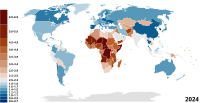
Photo from wikipedia
Simple Summary Mating disruption for insect pests can be an effective and environmentally sensible method. For landscape-level population management of forest insects, however, statistically rigorous experiments can be difficult to… Click to show full abstract
Simple Summary Mating disruption for insect pests can be an effective and environmentally sensible method. For landscape-level population management of forest insects, however, statistically rigorous experiments can be difficult to undertake. In 2021, we tested a new microencapsulated formulation (CONFOUNDSBW) that was designed specifically for low density spruce budworm populations in New Brunswick, Canada, in a fully replicated experiment. While adult trap catch was reduced by 90% in treatment blocks, larval density and apparent fecundity were not significantly affected when compared to those in untreated control blocks. Although mating disruption remains a potentially useful tool in landscape-level forest pest management, CONFOUNDSBW is not effective against spruce budworm at low population densities when applied in accordance to label rates and volumes. Abstract Choristoneura fumiferana (SBW) is a major defoliating pest of balsam fir and spruce in eastern North America. As part of an integrated management strategy for SBW, we evaluated the effectiveness of mating disruption as a landscape-level population control tactic. Using a sprayable formulation (CONFOUNDSBW) containing a synthetic sex pheromone blend, we treated five 300 ha blocks in Northern New Brunswick with an aerially applied microencapsulated mixture. There were significant reductions in adult trap catches in treated blocks compared to untreated control blocks. Branch sampling in treated blocks showed uniform distribution of CONFOUNDSBW deposition throughout the blocks. Population densities following treatment were not significantly affected when compared to densities in control blocks, or prior to treatment. Analysis of egg:adult ratios indicates that no immigration events occurred within treatment or control blocks. The lack of population reduction following treatment strongly suggests that widespread application of CONFOUNDSBW at a rate of 50 g of active ingredient per hectare is not an effective tool in controlling SBW populations.
Journal Title: Insects
Year Published: 2022
Link to full text (if available)
Share on Social Media: Sign Up to like & get
recommendations!